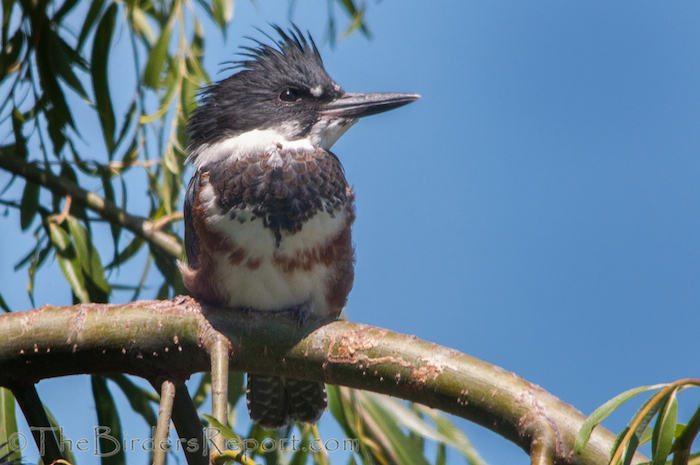The Belted Kingfisher by Linda Aldrich
If you’ve ever heard a loud rattling call and seen a flash of blue and white splash into the water, you have spotted a Belted Kingfisher, one of the more interesting denizens of the waterways of our area.
Follow the flight of this bird to a perch above the water and you will see a 13 inch stocky, big-headed creature with a stout dark bill, shaggy topknot of feathers on its head, small feet and a relatively short tail. The male bird has a slate blue head, wings and tail. The breast is white and encircled with a blue band which is the belt that gives it its name. The female has all of those features plus a second rusty red belt and reddish flanks. In most birds with plumage differences between the sexes, the male is more colorful; however, Ms. Kingfisher is the one sporting the flashier feathers in this species.
The feet of the Belted Kingfisher and its kin are unusual, too. Like a chicken, three toes point forward and one points to the back; but, unlike other bird groups, the forward-facing toes are partly fused together at their bases – a characteristic that probably comes in handy in nesting season. Belted Kingfishers dig a tunnel in a vertical bank above water to raise their families in.
They start work by flying full tilt into the bank beak first, then kick loosened soil out behind them with their feet. Both male and female construct the tunnel which is usually 3 to 6 feet deep (although one ambitious pair tunneled for 15 feet). At the end of the tunnel, they hollow out a chamber in which the female lays 5 to 8 white eggs. Both parents participate in incubating the eggs for about 3 weeks and then feed the voracious chicks (each eats 8 fish a day) for 4 weeks until they exit the tunnel. In past years, a pair of Belted Kingfishers has nested in a bank above the Sacramento River visible across the river from Anderson River Park.
The Belted Kingfisher’s fishing behavior is fun to watch. One of these birds will sit on a branch over-hanging water until it sees a fish near the surface. It will splash into the water (stop-motion videos show its eyes closed) and grasp the hapless fish firmly with its stout bill. The kingfisher than flies to a near-by branch and “tenderizes” its catch by bashing it against the branch, finally swallowing it whole. Occasionally, the bird will hover above the water to spot and catch a fish.
Although the Belted Kingfisher is the only kingfisher in most of the United States, there are about 90 species worldwide. These include the smallest, the tiny 4 inch African Dwarf Kingfisher, a forest dweller that eats insects (in common with many non-fishing species) and the Giant Kingfisher of Africa which is an 18 inch sturdily-built lunker. Surprisingly, the famous Laughing Kookaburra of Australia is actually a kingfisher.


Comments are closed.